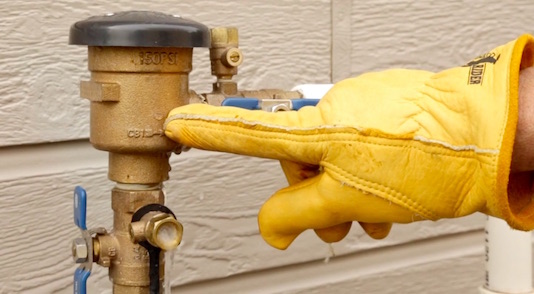Inspecting Residential Lawn Irrigation Systems
by Nick Gromicko, CMI®, Alan Nguyen and Kate
Tarasenko
Understanding how residential lawn irrigation systems work within the framework of a home inspection can be valuable in giving yourself a competitive edge. Although not required by InterNACHI’s Home Inspection Standards of Practice, offering this service – either as part of your own standard home inspection, or as an ancillary inspection – can put you ahead of inspectors in your service area who don’t provide this service.

Atmospheric breaker valve (photo courtesy of InterNACHI® member Jim Zarka)
What to Look For: The Basics
When examining the landscape at a residential property, it’s important to note three items:
- What kind of valve does the home use for irrigation? It may be an atmospheric vacuum breaker or a
double-check valve assembly.
- The spray heads used for watering are a critical component of the system.
Their positioning, pressure, and function via the manifold and its pipes all
affect the health of the lawn.
- The landscape itself is a key indicator about the effectiveness of the
lawn irrigation system. Where the grass may be greener, whether there are
depressions or damp spots, and where there may be yellow or dried-out areas are
all clues about the system’s performance.
The System’s Valves
Within InterNACHI’s How to Inspect Lawn Irrigation Systems course, we take a look at two primary valves that are used in private homes; the atmospheric valve breaker, and the double-check valve assembly. They prevent water from back-flowing into the potable water supply of the home and contaminating it. So, it’s vital to inspect either device to make sure it’s functioning properly.
An atmospheric vacuum breaker is generally located outside the home. It must be placed 6 inches above the sprinkler heads. Should there be a cracked or broken pipe somewhere within the system, this breaker valve prevents any possible backflow into the domestic water supply.
The double-check valve’s function is similar but does not need to be placed at a higher level than the sprinkler heads. It can be identified by two handles on the device. It’s typically found at ground level or in a valve box (which is also recommended to be installed below ground to avoid damage by mowing equipment, etc.).
Other Sprinkler System Components
Other items to look at are the nozzles. Which nozzles are used and how they are placed around the property provide key information for maintaining efficient water consumption for the household. Proper water distribution can be evaluated by observing how the water is dispersed from the sprinkler heads. If there’s any misting, that indicates that the water pressure is too high; if hardly any water is coming out, the pressure is too low. Such issues can be solved by either removing or adding another head to the same pipeline as a means of redistributing the water. Other factors to consider are whether the sprinkler heads are level and at the appropriate height off the ground; the idea is to have an even distribution of the water across all zones.
Checking the manifold is also an important
aspect of a lawn sprinkler system inspection, as the manifold can be prone to
damage when not maintained properly. The manifold acts as a conduit in the distribution
of water. It may have a drain valve that can be used to blow out the system at
the end of the watering season. Failure
to do so can lead to cracks in the underground system due to freezing in low
temperatures, which can compromise the entire system.
Optimum Distribution
In areas that receive a lot of wind, such as Colorado, it is generally recommended that the radius of spray of an individual head reach the next head over. In states that do not receive as much wind, the distance between each head is generally not as strict.
Similarly, the landscape as a whole can be used to identify potential issues. Areas that are more lush than others may hint at problems with cracks in the underground piping or even the quality of the soil. With regard to the soil, the deeper the roots of the grass, the better the soil will retain and nourish the lawn or plant life.
Another factor to consider is that plants generally need less water than the lawn, except for certain drought-resistant species. Additional water emitters or sprinkler heads should be planned if particular plants are expected to grow in height or spread laterally.
It should also be noted that plants should be watered using drip zones, which generally run at 30 psi. For plants that are expected to grow over the years, emitters should be planned ahead of time to compensate for the growth of the plant, as this will cause less disruption to both the water system and the landscape.
It's also critical that the sprinkler heads are not placed too close to the home's foundation or exterior deck or porch. Moisture intrusion into the home's interior can cause significant damage over time, especially if it's not noticed right away. Also, wooden deck and porch supports and decking that are soaked by the sprinkler system can become weakened, which can cause a catastrophic failure.
Conclusion
If not installed and maintained properly, a lawn irrigation system can create problems for the health of a property’s lawn. A faulty system can lead to wasteful water use, or, worse, contamination of the home’s potable water supply. Inspectors who want to stay competitive in areas where automatic sprinkler systems are commonplace can become trained in their inspection, which can translate into a profitable revenue stream.
Download your free copy of STACKS: A Home Inspector’s Guide to Increasing Gross Revenue.
Download your free copy of SLEEP WELL: A Home Inspector’s Guide to Managing Risk.
BizVelop: Free Business Development Tool for Home Inspectors

